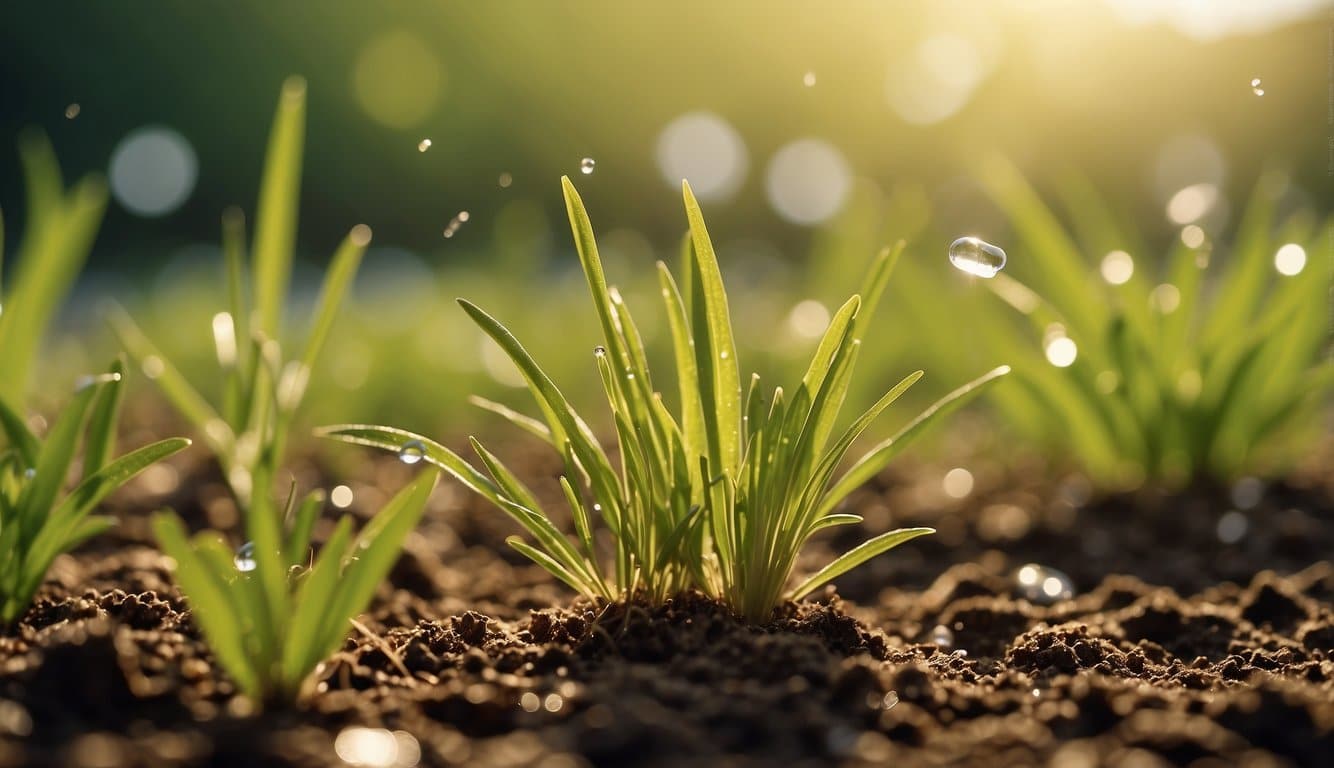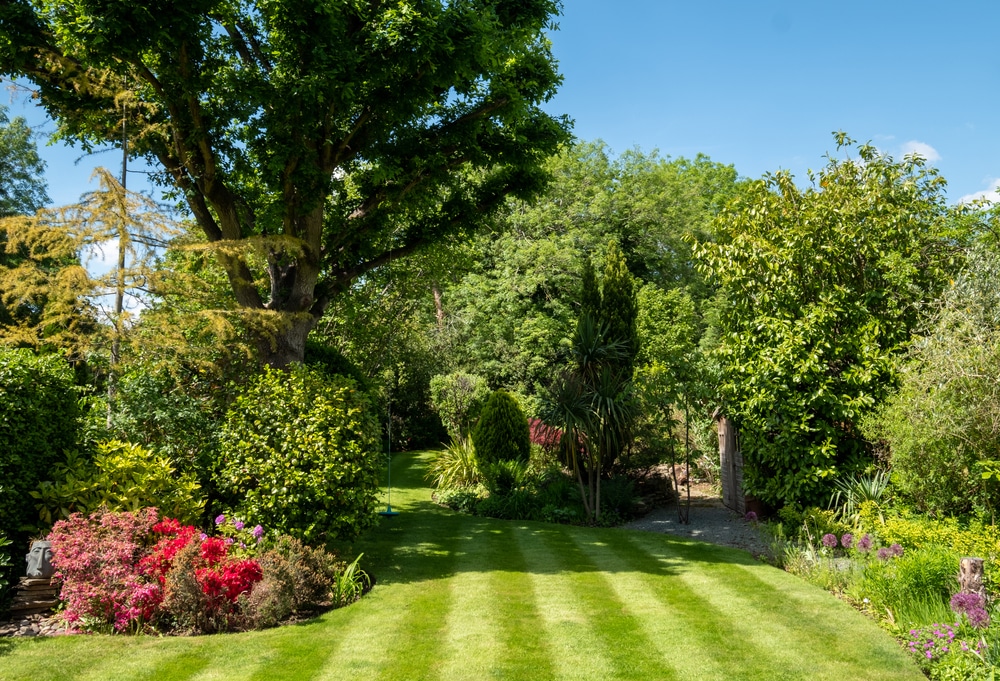Germination: 101
Germination is the critical first step in a plant’s life cycle, allowing a grass seed to grow into a mature plant. Your lawn’s lushness depends on this biological process, so grasping germination is key to successful lawn care.
Here’s a condensed guide:
- Water Uptake: The journey of germination begins with imbibition, where the seed absorbs water, initiating the growth process.
A significant change, the seed swells and enzymes activate to start the transformation.
- Temperature: The optimal temperature for germination is around 70°F. Too high or too low can impede or halt the process altogether.
- Oxygen Availability: Seeds need oxygen for respiration during germination. Limited oxygen can slow down or stop germination.
- Light Exposure: Some seeds require light to trigger germination, while others may sprout in darkness.
- Activation: Once conditions are favorable, seeds’ dormant enzymes awaken, kick-starting metabolism.
- Radicle Emergence: The first root, known as the radicle, breaks through the seed coat.
- Shoot Development: As the seedling strengthens, a shoot heads upwards towards the light source, and leaf growth begins.
By creating ideal conditions for these steps, you’ll see improved germination success and, ultimately, a more verdant lawn.
Remember, consistent moisture and appropriate temperatures are paramount for stimulating and maintaining this phenomenon.
What Helps Grass Seed Germinate
In your journey to a lush lawn, recognize that grass seed germination is highly dependent on specific environmental conditions. Each factor plays a crucial role in turning those tiny seeds into verdant grass.
Temperature and Germination
- Optimal Temperature Range: Different grass types have varying optimal temperature ranges that are essential for seed germination.
- For instance, cool-season grasses like perennial ryegrass require temperatures between 5-20°C (41-68°F).
- Heat and Dormancy: Excessive heat can induce dormancy in seeds, preventing germination even when all other conditions are favorable.
Moisture and Water Uptake
- Adequate Moisture Levels: Germination can’t occur without sufficient water, which enables seeds to imbibe water and activate the germination process.
- Balance is Key: While moisture is vital, over-saturation can lead to problems such as fungal growth or seed rot.
Soil Composition and Structure
- Soil pH: Ideal soil pH values typically range from 6.0 to 7.5 for most grass seeds, which allows for optimal nutrient absorption.
- Texture and Nutrients: Loamy soils rich in organic matter tend to provide the best conditions for grass seed germination due to their superior drainage and nutrient-retention properties.
Grass Seed Varieties and Their Germination Requirements
When you’re sowing grass seed, it’s crucial to know that different types of grass have specific needs to successfully sprout. Here are some common grass seed varieties and their germination requirements to help you cultivate a lush lawn.
- Kentucky Bluegrass:
- Optimal Soil Temperature: 55-65°F
- Germination Time: 14-30 days
- Water Needs: Consistent moisture is key during germination.
- Perennial Ryegrass:
- Optimal Soil Temperature: 50-65°F
- Germination Time: 5-10 days
- Water Needs: Requires frequent, light watering to prevent drying out.
- Tall Fescue:
- Optimal Soil Temperature: 50-65°F
- Germination Time: 7-12 days
- Water Needs: Evenly moist soil, avoid overwatering.
To ensure successful germination, your grass seeds require the right environmental conditions and care. Here’s what you should consider:
- Soil Temperature: Grass seeds germinate best within specific soil temperature ranges. A Soil thermometer can be an invaluable tool for you.
- Moisture: Seeds need constant moisture to germinate. Automatic sprinklers or manual watering can maintain necessary moisture levels without over-saturating the soil.
- Sunlight: Although seeds initially don’t require light to germinate, once they break through the soil surface, adequate sunlight is essential for growth.
- Soil Preparation: A fine, loose, and weed-free seedbed promotes better seed contact with the soil.
Pre-Germination Treatments
Pre-germination treatments can significantly improve the success rate of grass seed germination. These preparatory steps can stimulate faster and more uniform sprouting, aiding in robust lawn establishment.
Seed Scarification
Seed scarification breaches the tough outer coating of grass seeds to promote water absorption and hasten germination. Different methods of scarification include:
- Mechanical scarification: Rubbing seeds between two abrasive surfaces.
- Thermal scarification: Exposing seeds to heat to crack the seed coat.
- Chemical scarification: Using mild acids to wear down the seed’s exterior.
By scarifying your seeds, you’re effectively mimicking the natural processes that weaken the seed coat, allowing water and oxygen to enter more easily.
Seed Stratification
Seed stratification is the process of exposing seeds to cold, moist conditions to break dormancy and simulate winter conditions. Steps include:
- Mixing seeds with a moist medium like sand or peat moss.
- Sealing this mixture in a container or bag.
- Refrigerating for a specified period, which varies depending on the grass species.
By stratifying your seeds, you trigger the end of dormancy, preparing them to sprout when returned to warmer conditions.
Priming and Hydration
Priming and hydration treatments optimize moisture levels within the seeds to promote germination upon planting. This involves:
- Soaking seeds in water for a specific time to allow for water imbibition.
- Draining and then keeping the seeds in a humid environment until they reach the “primed” state.
Treating seeds with smoke-infused water is another method, particularly for species that rely on smoke to cue germination. Properly primed seeds have a physiological advantage, which often leads to more synchronized and rapid growth once sown.
Monitoring and Managing Germination
To achieve a lush green lawn, it’s crucial you stay on top of the grass seed germination process. It’s not simply about sowing and waiting; you must test, identify ideal conditions, and care for your seeds post-germination.
Germination Testing
- Conduct a Germination Test: To ensure your grass seeds are viable, conduct a test before sowing.
- Place 10 seeds on a damp paper towel and cover them with another. Keep them in a warm area and check daily for sprouting.
- Record Sprouting Seeds: Keep a tally of how many seeds sprout to calculate the germination rate.
- A high rate indicates good seed health, while a lower rate may lead you to invest in fresher seeds for your landscaping.
Germination Rate Factors
To help your seeds germinate efficiently, be mindful of:
- Temperature: Most grass seeds have a specific optimum temperature for germination.
- Measure soil temperature to identify the perfect sowing window.
- Soil Moisture: Keep the soil consistently moist, not waterlogged. Use a spray bottle to gently mist the area as needed.
- Light: Some seeds require light to germinate, while others prefer darkness. Research your grass type to ensure correct exposure.
- Soil Quality: Prepare your soil by removing debris and breaking up large clumps.
- A smooth, nutrient-rich seedbed promotes better germination results.
Post-Germination Care
Once your grass seeds have sprouted, your care regimen shifts:
- Water Wisely: Gradually reduce watering frequency to encourage deep root growth but maintain even soil moisture.
- First Mowing: Wait until your grass is about three inches tall before the first cut. This allows the roots to strengthen and avoid stress from premature mowing.
- Nutrition: Fertilize lightly after the first few mowings to support growth, choosing a product designed for young grass.
Frequently Asked Questions
As you navigate the complexities of lawn care, grasping the essentials of grass seed germination is crucial for a healthy, lush garden.
What are the stages of grass seed germination?
- Imbibition: Water absorption by the seed, causing it to swell.
- Activation: Enzymes within the seed become active.
- Radicle Emergence: The seed’s root emerges to anchor the plant.
- Shoot Emergence: The shoot rises towards the soil surface.
At what temperature does grass seed typically germinate?
Grass seed germinates best at temperatures around 70°F (21°C).
The range can be between 60°F and 75°F (15°C-24°C) for most grass types.
What factors influence the germination rate of grass seed?
- Moisture: Seeds need consistent moisture to germinate.
- Temperature: Moderate temperatures are crucial for germination.
- Light: Some seeds require light, whereas others need darkness.
- Soil Condition: Nutrient-rich, well-aerated soil aids germination.
How can you identify if grass seed has started to germinate?
When grass seed has started to germinate, you’ll notice the sprout pushing up through the soil.
Within two weeks you should see evidence of this growth.
What are the differences between seed germination and seed emergence?
- Germination: The process of a seed beginning to grow.
- Emergence: The point when the new plant first becomes visible above the soil.
What techniques can be used to accelerate the germination process of grass seed?
- Pre-soaking: Moistening seeds before planting to reduce germination time.
- Proper Seeding Depth: Planting seeds at the correct depth ensures adequate protection and moisture.
- Use of Mulch: Mulch helps to retain moisture and maintain temperature.
- Choosing the Right Season: Planting during seasons with optimal conditions for the specific grass type.
Last update on 2024-04-29 / Affiliate links / Images from Amazon Product Advertising API





